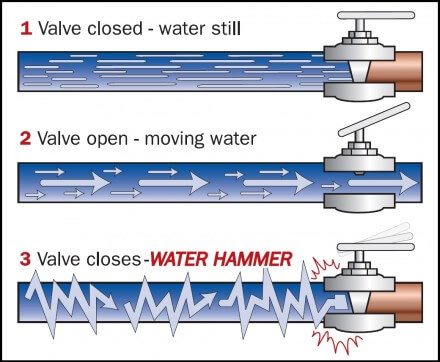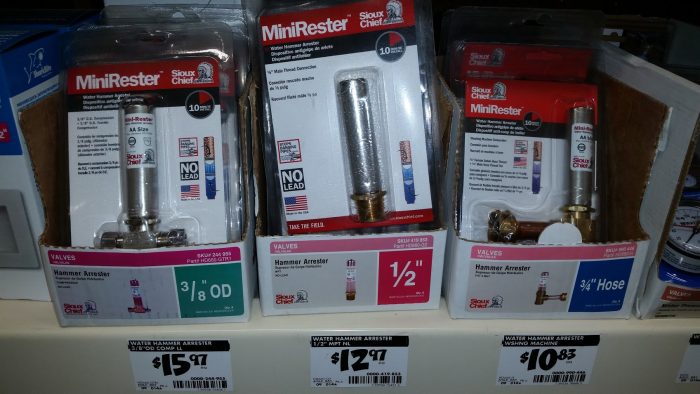Minnesota adopted a new plumbing code in January of this year, and of course, that brought many new plumbing code requirements. I blogged about the new Minnesota plumbing code earlier this year, but one new change that I never mentioned is the requirement for water hammer arresters. The old Minnesota plumbing code required “protective devices or approved mechanical shock absorbers” to be installed when noises were created due to water hammer (4715.1750), but the new plumbing code doesn’t give any kind of wiggle room, specifying exactly how this must be done.
The new plumbing code says the following:
609.10 Water Hammer. Building water supply systems where quick-acting valves are installed shall be provided with water hammer arrester(s) to absorb high pressures resulting from the quick closing of these valves. Water hammer arresters shall be approved mechanical devices in accordance with the applicable standard(s) referenced in Table 1401.1 and shall be installed as close as possible to quick-acting valves.
In other words, water hammer arresters are now required; they’re not just kinda suggested. The places that you’ll most commonly find “quick-acting valves” will be at dishwashers and clothes washing machines. Also, the standard referenced in Table 1401.1 is ASSE 1010-2004, Water Hammer Arresters.
More on water hammer
Water hammer occurs when a bunch of flowing water is suddenly stopped, causing a shockwave as shown in the diagram below:

While water hammer is worst with the aforementioned quick-acting valves, it can really happen anywhere. I had a small problem with this at my own kitchen sink after replacing my 1/2″ water line with a 3/8″ water line to get hot water to my sink faster. All it took to fix this issue was to secure the water line, but the “before” video was quite dramatic. All that I’m doing in the video below to get the pipe to bang is turning my hot water on and off at the kitchen faucet.
The most common water hammer arresters that I find in homes are made by Sioux Chief. There is some excellent information about water hammer arresters on the Sioux Chief website, along with some good video clips showing how water hammer arresters operate:
These products are available at home improvement stores and plumbing supply stores. The most common place for water hammer is at washing machine hoses. If you experience water hammer at your own washing machine connections, the quick and easy solution is to purchase a set of water hammer arresters made specifically for washing machines. These have a standard 3/4″ hose thread and are about as much work to install as connecting a garden hose to a faucet.
Author: Reuben Saltzman, Structure Tech Home Inspections


Brian Collins
July 5, 2016, 6:34 am
Since water is not compressible could that be placed anywhere along the travel path? For instance at the cold water inlet of the water heater?
Reuben Saltzman
July 5, 2016, 12:01 pm
@Brian – Yes, these devices will help no matter where they’re installed, but they’re most effective when installed next to the offending fixture or valve.
Luke Schwartzbauer
July 5, 2016, 6:54 am
Thanks for the blog Reuben, lots of good info here each week.
I’ve noticed water hammer in my home since we moved in a couple years ago. Not only on fast closing devices, but also if the kids shut the water off quickly. I’m currently renovating our laundry room, and put in a new water supply box (not exactly sure what they are called) from Oatley that has built in arresters. I may be imagining things, but it seems to have helped throughout the house. Does that make sense? If so would it help to just put a set of arresters in the utility room, or should they be installed right at the appliances/faucets?
Reuben Saltzman
July 5, 2016, 12:04 pm
@Luke – yes, that makes perfect sense, and surely does help. It was actually common to have a big air chamber installed near the water meter in old houses in Saint Paul. I discussed this in an old blog post from 2012: http://structuretech1.com/2012/06/water-hammer/ . Water hammer arrestors are most effective when installed next to the offending fixture or valve, however.
Art Jacobson
July 6, 2016, 9:11 am
Does this mean that if you replace a dishwasher that you are supposed to install one of these in addition to the air gap you mentioned in your plumbing code blog?
Reuben Saltzman
July 6, 2016, 11:56 am
Great question. That will be up to the individual city plumbing inspectors. For the homes that we’ve inspected so far that have had dishwashers installed under the new code, none of them have had water hammer arresters installed. So in other words, *probably* not.
Ron Miller
July 28, 2016, 5:43 am
I took your suggestion regarding the under the sink soap dispenser. It worked great for a couple of weeks and then the tube floated to the top of the bottle and fell out of the bottle. The soap that was in the tube spilled on to the floor of the cabinet. Do you know what I can do to avoid this from happening?
Reuben Saltzman
July 28, 2016, 11:04 am
Hi Ron,
A small bit of duct tape should work. Another option would be to keep the lid for the container of soap and drill a hole through it that is slightly smaller than your tubing, and feed the tubing through the lid. Yet another would be to use semi-rigid tubing that is an exact length; this couldn’t possibly come out.